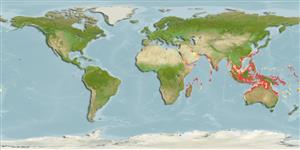Common names from other countries
>
Acanthuriformes (Surgeonfishes) >
Siganidae (Rabbitfishes)
Etymology: Siganus: Latin, siganus = a fish, rabbit fish; by the similarity of the nose (Ref. 45335).
Environment: milieu / climate zone / depth range / distribution range
Sinh thái học
Biển; Thuộc về nước lợ Cùng sống ở rạn san hô; Ở đại duơng, biển (Ref. 51243); Mức độ sâu 1 - 50 m (Ref. 9813). Tropical; 30°N - 35°S, 49°E - 174°W
Indo-West Pacific: Persian Gulf, Gulf of Oman, Pakistan, India, Sri Lanka, Burma, Thailand, Singapore, Malaysia, Indonesia, Papua New Guinea, Philippines, Cambodia, Viet Nam, south China, Taiwan and Western Australia. Also known from Ryukyu Islands; Palau and Yap in Micronesia (Ref. 1602) and Melanesia (Ref. 712).
Length at first maturity / Bộ gần gũi / Khối lượng (Trọng lượng) / Age
Maturity: Lm 11.6, range 12 - ? cm
Max length : 40.0 cm TL con đực/không giới tính; (Ref. 108696); common length : 20.0 cm TL con đực/không giới tính; (Ref. 9813)
Các tia vây lưng cứng (tổng cộng) : 13; Các vây lưng mềm (tổng cộng) : 10; Tia cứng vây hậu môn: 7; Tia mềm vây hậu môn: 9; Động vật có xương sống: 23. This species is distinguished by the following characters: body compressed, moderately slender, its depth 2.3-2.8 in SL; last anal-fin spine 1.2-1.5 times in longest anal-fin spine (usually the third); soft parts of dorsal and anal fins low, longest dorsal-fin ray 0.7-1 times in longest dorsal-fin spine; caudal fin almost emarginate in specimens under 10 cm standard length, forked in larger fish; 16-26 (rarely 27) scale rows between lateral line and bases of leading dorsal-fin spines. Colour of body highly variable, greenish grey to yellow brown with numerous (100-200) pearly blue to whitish spots on nape and trunk, match-head size on lower sides; 2-3 rows between first spine of dorsal fin and lateral line (area of eye would cover about 6 spots in this region), and about 10 rows between highest point of lateral line and base of first anal-fin spine; when frightened or injured, sides mottled light and dark brown and cream, creating 6 or 7 regularly spaced, dark diagonal zones with paler zones of similar width between them; dark eye-sized spot usually just behind upper end of gill opening, and a narrow bar along upper edge of gill cover (Ref. 9813, 90102).
Adults inhabit inshore, algae reefs, estuaries and in large lagoons with algae-rubble habitats. Mainly common on rocky substrates (Ref. 48637). In contrast to S. fuscescens, this species seems to tolerate more turbid waters, occurring within the vicinity of river mouths especially around seagrass beds. Adults also occur several kilometers offshore in deep, clear waters. Juveniles form very large schools in shallow bays and coral reef flats; school size reduces with size, with adults occurring in groups of 20 individuals or so. Herbivorous, feed on benthic algae and to some extent on seagrass. Fished by trawling and seine netting; bycatch in traps set in deep water and marketed fresh in very large numbers (Ref. 9813). Consumed as food; and have poisonous spines (Ref. 4537).
Multiple spawner (Ref. 1753). Larger fish may spawn more than once in a spawning season (Ref. 1753). Spawn in group (Ref. 240).
Woodland, D.J., 1990. Revision of the fish family Siganidae with descriptions of two new species and comments on distribution and biology. Indo-Pac. Fish. (19):136 p. (Ref. 1419)
IUCN Red List Status (Ref. 130435)
CITES (Ref. 128078)
Not Evaluated
Human uses
Các nghề cá: Tính thương mại; Nuôi trồng thủy sản: Tính thương mại
Các công cụ
Special reports
Download XML
Các nguồn internet
Estimates based on models
Preferred temperature (Ref.
115969): 24.7 - 29.1, mean 28.3 (based on 1218 cells).
Phylogenetic diversity index (Ref.
82804): PD
50 = 0.5000 [Uniqueness, from 0.5 = low to 2.0 = high].
Bayesian length-weight: a=0.01445 (0.01148 - 0.01820), b=2.98 (2.93 - 3.03), in cm Total Length, based on LWR estimates for this species (Ref.
93245).
Mức dinh dưỡng (Ref.
69278): 3.2 ±0.30 se; based on food items.
Thích nghi nhanh (Ref.
120179): Trung bình, thời gian nhân đôi của chủng quần tối thiểu là 1.4 - 4.4 năm (K=1.5-2.0; tm=1; tmax=7.8).
Fishing Vulnerability (Ref.
59153): Low to moderate vulnerability (31 of 100).
